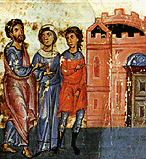 |
|
 |
Migration
 The economic decline of a state always goes hand in
The economic decline of a state always goes hand in
 hand with an increased mobility of its population. hand with an increased mobility of its population.
This phenomenon, which was noted during the entire Late Byzantine period, even in peaceful times, manifested itself more acutely during times of enemy invasions and civil wars. This is attested by the censuses that are found in chronological order concerning Macedonia in the first half of the 14th century. We can thus see that, in the time intervening between one census and another, not only certain members of families, but whole families have disappeared, and even entire villages have been abandoned. Nonetheless, there were villages in which new families settled, and this because, during their migration, individuals or families made their way towards neighbouring villages or looked for lands and places to stay that were safer. In fact, in times of crisis, many sought the security of fortified cities. The family names appearing in a certain place often allow us to guess the provenance of the immigrants.
Families
and people with very small properties or none at all, who were usually not registered on tax lists and who were used as manual labour in various jobs, that is the free workers, the aktemones ("landless") and the aporoi ("paupers") as they are called in written sources, showed a greater degree of mobility. It is certain that the paroikoi, too, however, who constituted the greater part of the rural population and who should normally have moved very little, did migrate as well.
The population was obliged to move either for
reasons of security because of enemy invasions, or because it became
increasingly difficult to live in a certain place, as the rural household
gradually sank deeper into destitution.
|